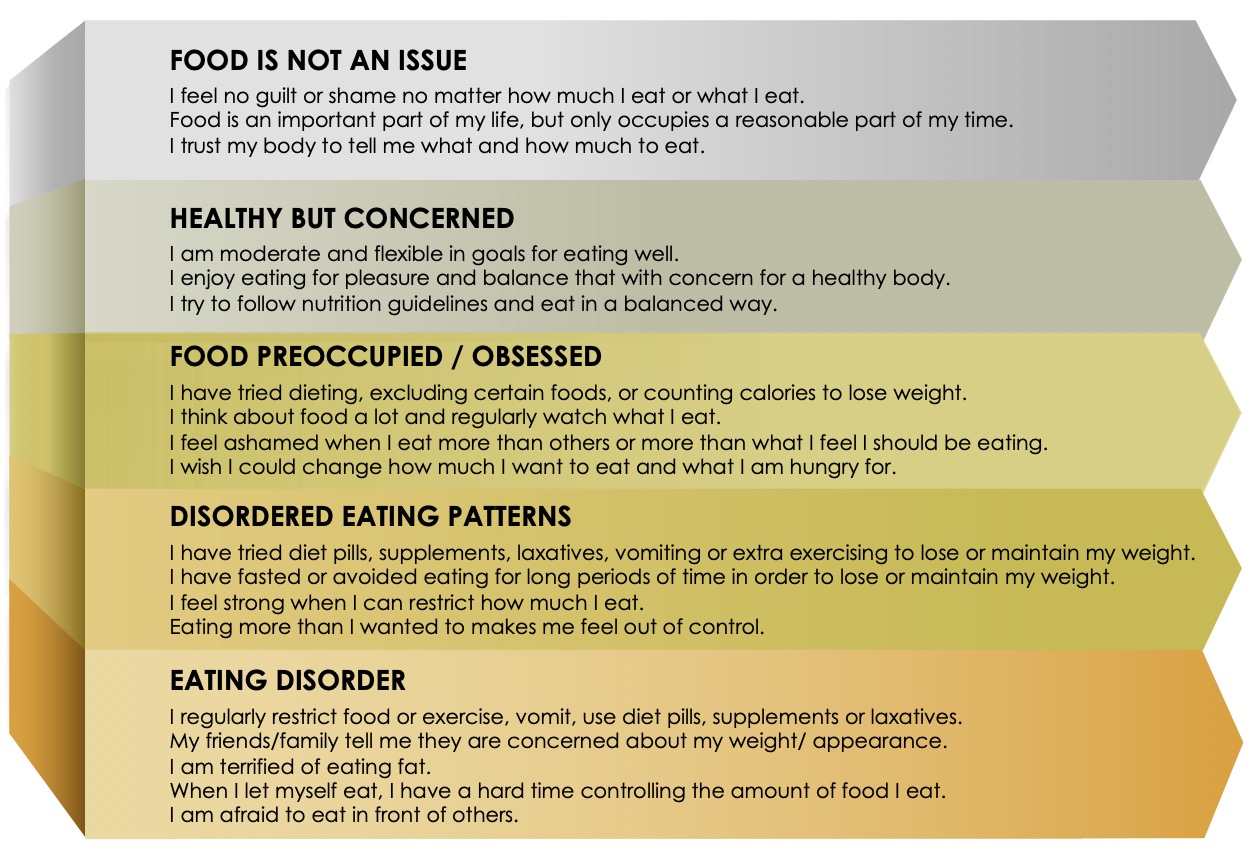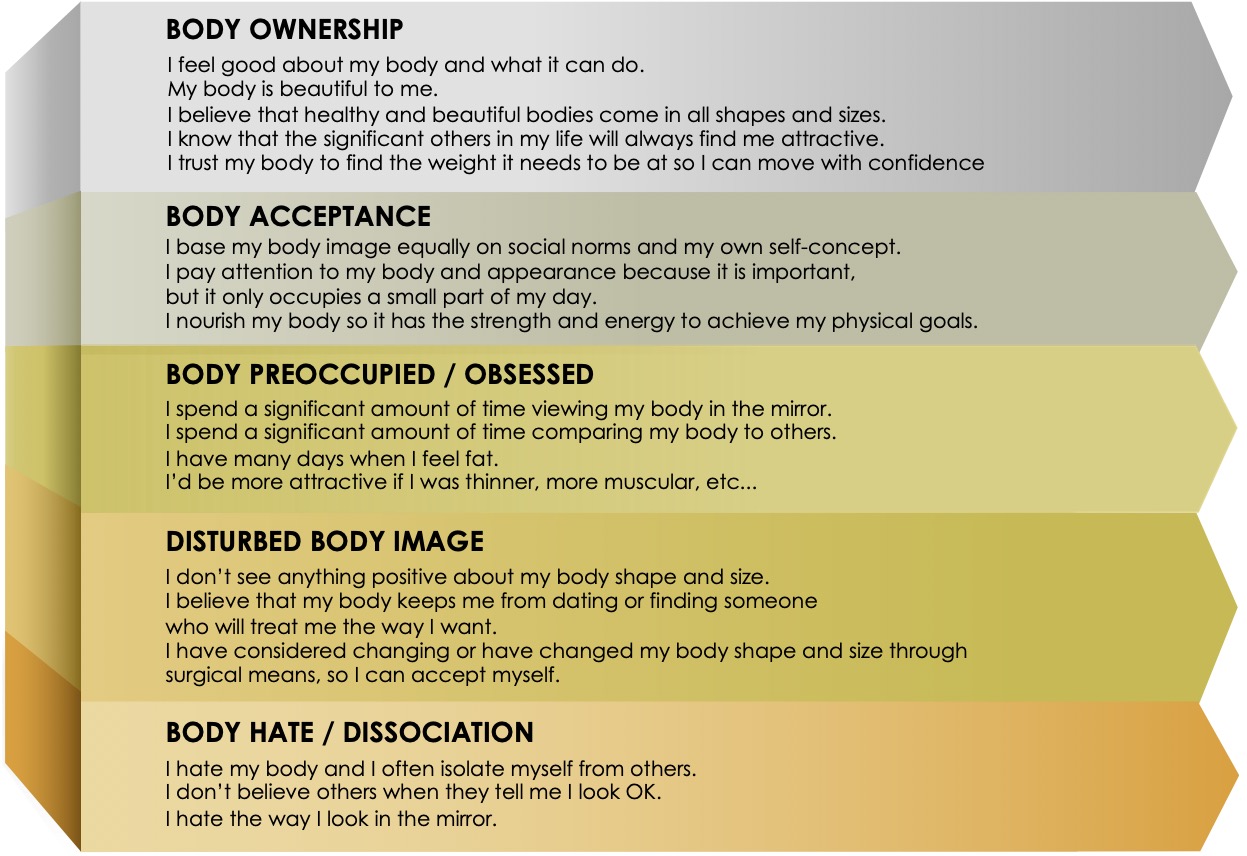18.6 Body Image: Definitions to Know
A person’s body image is defined by their internal perceptions, thoughts, and evaluation of one’s own outward physical appearance. Body image exists on a continuum, with one end being body appreciation and the other end being extreme body dissatisfaction. Every person falls somewhere on this continuum and moves fluidly along this continuum over time, based on a variety of factors, including age, life events, and medical conditions. Body image can be influenced by, but is also in some ways independent from, a person’s relationship with food, level of physical activity, and other forms of self-care. For example, a person may have a positive relationship with food and at the same time experience body dissatisfaction. Or, a person may notice their body appreciation increases as they practice more strength training exercises.
The Eating Issues and Body Image Continuum
This content from the University of Arizona was adapted by staff at Cornell Health and is used with permission, 2018.
The eating issues and body image continuum illustrates the spectrum of feelings and attitudes an individual can experience toward food and their body. An individual can be in one column for food and another for body image; may exhibit some, but not all, characteristics within a category; and can move from one category to another across the continuum depending on changes that occur in their self‐esteem and attitudes toward food or body image.
Visit an accessible version of the eating issues continuum and body issues continuum tables.
Table 1: Eating Issues Continuum

Table 2: Body Image Continuum

Body dissatisfaction refers to an individual’s negative subjective evaluation of their body or shape (Stice & Shaw, 2002). Body image dissatisfaction has been shown to be associated with higher levels of anxiety, depression, disordered eating, lower levels of self-esteem, and adverse impacts on mental health (Pimenta, Sánchez-Villegas, Bes-Rastrollo, López, & Martínez-González, 2009; Szymanski & Henning, 2007; Neumark-Sztainer, Paxton, Hannan, Haines, & Story, 2006; Grossbard, Lee, Neighbors, & Larimer, 2009; Ganem, de Heer, & Morera, 2009). Body dissatisfaction can include a variety of thinking patterns and behaviors including preoccupation, body image disturbances, and body hate. Even within the spectrum of body dissatisfaction exists a range of thoughts, emotions, and levels of dissatisfaction.
Body image flexibility is a person’s ability to accept negative thoughts about their body without letting the thoughts derail valued behaviors or goals around wellbeing. In other words, a person can fully and openly experience body image dissatisfaction and continue self-care practices that are important to them. Body image flexibility is associated with psychological flexibility and wellbeing, lower body dissatisfaction, and is predictive of lowered likelihood of developing an eating disorder (Sandoz, Wilson, Merwin, & Kellum, 2013; Pellizzer, Waller, & Wade, 2018). Body image flexibility overlaps with the concept of body acceptance on the Body Image Continuum.
Body appreciation—sometimes referred to as body ownership—is characterized by respect, acceptance, and having positive opinions toward one’s body, while at the same time resisting and rejecting appearance-related ideals portrayed in the media or promoted by societal influences. Body appreciation is positively associated with measures of psychological wellbeing, more intuitive eating, sexual satisfaction, and engagement in physical activity, especially activity not driven by appearance-related motives (Avalos, Tylka, & Wood-Barcalow, 2005; Homan & Tylka, 2014; Satinsky, Reece, Dennis, Sanders, & Bardzell, 2012; Swami, Hadji-Michael, & Furnham, 2008; Tylka & Kroon Van Diest, 2013; Wasylkiw, MacKinnon, & MacLellan, 2012). Characteristics of body appreciation include listening to hunger cues, feeding ourselves mindfully, engaging in physical activity we enjoy, and accepting the bodily changes that result.
Optional Activity: Body Appreciation Scale-2
If you’re curious about a tool clinicians use to jumpstart conversations around body image or body appreciation, you can read the article linked below to learn about how the items were developed, revised, and validated. The actual items can be found in the appendix just before the references.
Scores range from 1 to 5, with higher scores indicating greater body appreciation. Higher levels of body appreciation are associated with lower body dissatisfaction, better self-esteem and more proactive coping, like creating and working toward challenging goals and overcoming obstacles.
Optional Reflection: What Does Your Body Do For You?
Take a moment to think about your body’s abilities, not its appearance or features. What does your body do for you? We have listed a few examples below to get you started:
- My body digests my food and turns it into energy so I can do the things I enjoy.
- My legs hold up my trunk, which holds my arms and heads through a strong display of balance each day.
- My ears capture the sounds around me, including my favorite sound ____.
- My muscles lift my child(ren) and allow me to hold them.
- The muscles in my shoulders, arms, and hands move the wheels on my chair to get me where I need to go.
- A time I felt strong and capable was when I _____.
- My body allows me to _____.
Self-Assess Your Understanding
- Consider the utility of the food issues and body image continuums.
- How might this changed over time for an individual?
defined by their internal perceptions, thoughts, and evaluation of one’s own outward physical appearance; exists on a continuum from body appreciation to extreme body dissatisfaction
an individual’s negative subjective evaluation of their body or shape
the ability to accept negative thoughts about their body without letting the thoughts derail valued behaviors or goals around wellbeing
sometimes referred to as body ownership; characterized by respect, acceptance, and having positive opinions toward one's body, while at the same time resisting and rejecting appearance-related ideals portrayed in the media or promoted by societal influences

